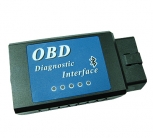ELM327 bluetooth - wireless car diagnostic scanner
Features of elm 327 bluetooth:
The ELM327 Bluetooth v 2.1 adapter is both a convenient and modern tool for carrying out complex diagnostics of a car based on a personal computer. All kinds of OBD-II protocols are supported and elm 327 bluetooth supports a huge number of specialized diagnostic programs. Unlike the USB version of elm 327 v2.1, it allows you to carry out diagnostics at a distance, in addition, it can be used not only with a personal computer, but also with a PDA and a mobile phone (appropriate software is required). The list of supported vehicles includes almost all fuel injected passenger cars manufactured after 1996. More information about compatibility can be found on this page
Revision: ELM327 v 2.1
Interface: Bluetooth
Supported elm327 cars briefly ( list more ) OBD-II:
Audi, Opel, VW, Ford, Jaguar, Renault, Peugeot, Chrysler, Porsche, Volvo, Saab, Mazda, Mitsubishi
Daewoo, Hyundai, KIA
Honda, Infinity, Lexus, Nissan, Toyota, Audi, BMW, Mercedes, Porsche
Buick, Cadillac, Chevrolet, Chrysler, Dodge, GM, Isuzu
Ford, Lincoln, Mazda
Supported OBD-II protocols:
- SAE J1850 PWM (41.6 kbaud)
- SAE J1850 VPW (10.4 kbaud)
- ISO 9141-2 (5 baud init, 10.4 kbaud)
- ISO 14230-4 KWP (5 baud init, 10.4 kbaud)
- ISO 14230-4 KWP (fast init, 10.4 kbaud)
- ISO 15765-4 CAN (11 bit ID, 500 kbaud)
- ISO 15765-4 CAN (29 bit ID, 500 kbaud)
- ISO 15765-4 CAN (11 bit ID, 250 kbaud)
- ISO 15765-4 CAN (29 bit ID, 250 kbaud)
- SAE J1939
Baud rate: 9600 or 38400 kbps
LED indicators: OBD Tx/Rx, RS232 Tx/Rx,
Power Operating voltage: 12V, built-in power overload and short circuit protection
Current consumption: 45 mA
Description:
Using the ELM327 Bluetooth v 2.1 adapter, you can perform the following operations:
• Read diagnostic trouble codes, both standard and manufacturer-specific codes, and display their meaning (more than 3,000 different error codes are listed in the database)
• Clear errors and turn off the MIL (“Check Engine” inscription on the dashboard).
• Display values from various sensors including:
- Engine RPM
- Engine Load
- Coolant Temperature - Fuel
System Status
- Vehicle Speed
- Short Term Fuel Consumption -
Long Term Fuel Consumption
- Absolute Air Pressure
- Ignition Advance
- Intake Air Temperature
- Mass Air Flow
- Throttle position
- Lambda probe
- Fuel pressure
- More...
